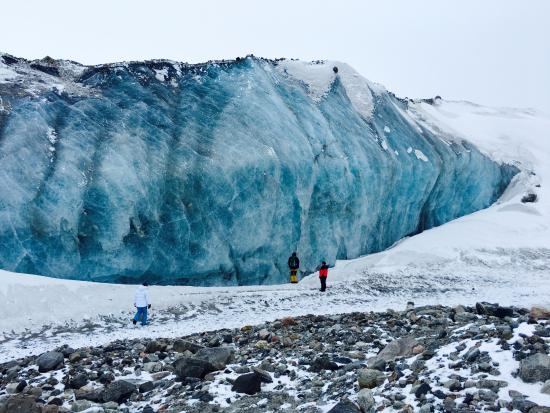2.2 Hydrosphere/Cryosphere
As a main point of the cryosphere, glaciers affect sea levels and Earth's temperature by reflecting sunlight. However, several glaciers are receding at a startling rate as a result of climate change. to point out the effects of glacial retreat, this blog compares historical and contemporary photos of Greenland's Kangerlussuaq Glacier. The research draws attention to the threats that melting glaciers bring to freshwater supplies, coastal populations, and ecosystems.
Reference: NASA (1984).
The second image was taken in 2020 and shows significant alterations. Over the 36 years, the glacier's terminus has receded by around 11.9 kilometers. A sizable proglacial lake has formed where the glacier formerly was due to this retreat, indicating a considerable thinning and reduced ice mass. the overall cause of this decrease is the increase in oceanic and atmospheric temperatures, which has sped up the melting of Greenland's ice. During this period, the glacier's surface area has shrunk by around 40 square miles.
Reference: Google Earth, 2020.
Image 3 Satellite Kangerlussuaq Glacier (2020)
Using Google Earth, I captured a satellite view of the Kangerlussuaq Glacier from a similar angle as the previous two images. The glacier’s retreat is clear, with the terminus much farther inland. The surrounding landscape now features more exposed rock and water, indicating the loss of ice. This view highlights the changes over time and underscores how much of the glacier has melted.
Citation: Google Earth (2020).
Problem: Glacial Retreat and Climate Change
A very clear illustration of the issue of glacier retreat is the retreat of the Kangerlussuaq Glacier. caused from rising global temperatures brought on by a rise in greenhouse gas concentrations in the atmosphere, glaciers like this one are receding. by slowing the increase of ocean temperatures and solar radiation , glacial ice acts as a very natural buffer against global sea level rise. But as glaciers melt, local ecosystems are impacted and sea levels rise as a direct result.
The interruption of freshwater sources is one important effect of glacier retreat. Glaciers provide freshwater to many populations, especially in the dry seasons. Because melting glaciers change how freshwater enters the ocean, it can disrupt marine ecosystems.
Explanation
The increasingly fast regression of the Kangerlussuaq Glacier serves as a prevelent reminder of the threats to our ecosystem that climate change poses. Glaciers are receding due to a number of causes, including as increasing runoff from melting ice, less precipitation, and rising temperatures. That is most noticeable in Greenland, where melting ice affects regional ecosystems and causes raises in sea levels around the world. The Sea levels might go up by 20 feet if the Greenland Ice Sheet completely melted, causing danger to populations all over the world.
References
NASA Earth Observatory. (1984). Kangerlussuaq Glacier Terminus. Retrieved from https://earthobservatory.nasa.gov/
Google Earth. (2020). Kangerlussuaq Glacier Satellite View. Retrieved from https://earth.google.com/
Grammarly to proof




Comments
Post a Comment